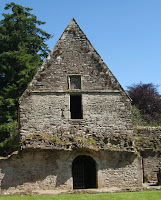Established in 1238, on the site of a previous church, Inchmahome Priory was a haven of peace and spirituality on the largest of the three islands on the lake, with its community of Augustinians, their parishoners and visitors. But like most of England and Scotland in the 16th century, the Protestant Reformation intervened and this gentle way of life came to an end. The monastic church and cloisters are mostly in ruins, although there is still a sense of how they must have appeared when complete.
Fortunately, the former Chapter House was renovated and used as a mausoleum during the 17th century and it is the only building still intact. At one time, the Chapter House was of great importance as a meeting place for the canons to discuss the business of the priory. They would sit on the stone benches around the sides of the room and listen to readings before getting down to business matters.
Those stone benches still exist and as I sat on one in the perfect silence and felt the cold seep through my trousers, I could imagine those long ago Augustinian brothers in the midst of their business.
After becoming a mausoleum in the 1600s, the Chapter House lay complete and now houses some of the carved stones from the priory. However, it is the striking effigy of Walter Stewart who died in 1295, and his wife, Mary, that immediately grabs the attention, as they lie almost entwined together for all eternity. There is also an effigy of an armed knight and a 14th century gravestone.
One of the most famous visitors to the island was the child, Mary Queen of Scots, who stayed at Inchmahome Priory for three weeks in 1547. The only reminder of her time there is a bower of boxwood trees to commemorate her visit.
This little island is still a unique area of wildlife and tranquility. We visited it during the busy school holidays, yet for all the people there that day, and children's laughing voices as they played amongst the ruins, there was a strange sense of solitide. Wandering through the ruins and sitting on the cold stone bench in the Chapter House, it was almost as though these other modern people hardly existed. Even the young girl who piloted the small boat mentioned the sense of peace on the island.
It was a special day out to this small island, where the relics and ghosts of the past still leave their mark on modern day visitors. I will certainly return at a less buy time of year and soak up the lingering atmosphere of a more spiritual, gentler way of life.
Romy





8 comments:
It looks so lovely and peaceful. We all need to find places like these where we can restore our spirits and find an oasis from the hectic world.
Hi Joanne - thanks for commenting! I'd love to go back on a quieter day to absorb more of the atmosphere.
What a beautiful place and to think the bower of boxwood trees is still there after all this time.
Hi Debs - thanks for your comment! It was very peaceful.
Really love the look of this place - I will have to go sometime. The photos are excellent, really atmospheric.
Hi Victoria - you'd like it. We'll need to go soon - I'd love to go back for more atmosphere!
I'm going to have to holiday in Scotland sometime. It looks idyllic.
There are many idyllic parts, Carol - can't believe it took me so long to visit this one!
Post a Comment